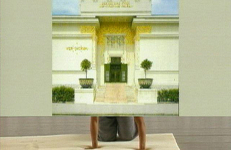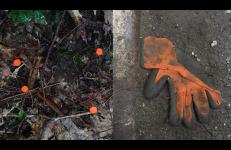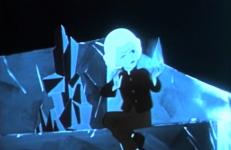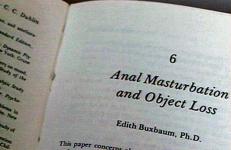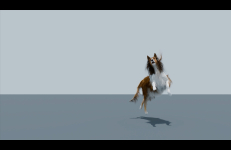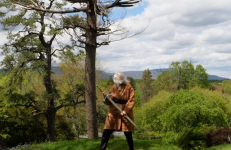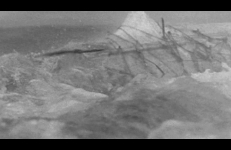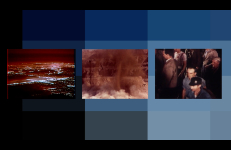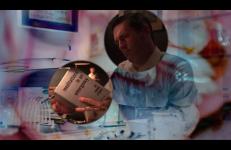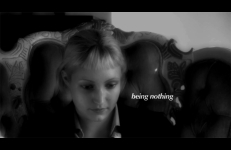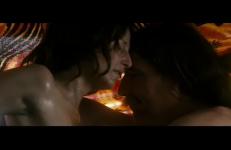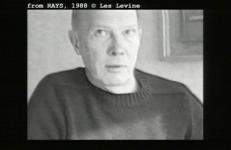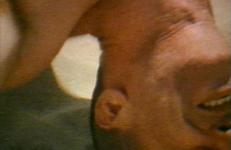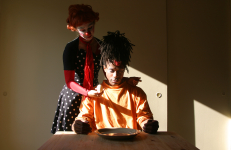Yvonne Rainer combines a dance performance she choreographed for Mikhail Barryshnikov’s White Oak Dance Project in 2000 with texts by Oscar Kokoschka, Adolf Loos, Arnold Schoenberg, and Ludwig Wittgenstein—four of the most radical innovators in painting, architecture, music, and philosophy to emerge from fin-de-siècle Vienna.
Literature
For over two years we made it our business to document abandoned working gloves on the streets of NYC. The feelings and thoughts that surrounded this activity connected to the ways his family relates to Gregor Samsa as a cockroach, or whatever Franz Kafka intended him to be in The Metamorphosis after his transformation from a productive citizen to a useless insect. When Gregor can't grant them a comfortable life-style any longer, his family starts to resent and hate the once loved and respected provider, finds him disgusting.
A ship sets sail on an epic voyage through malignant natural and supernatural elements from which one man alone survives. An adaptation of Samuel Taylor Coleridge's The Rime of the Ancient Mariner illustrated by19th Century wood engravings which are animated by scratching directly into the surface of color filmstock.
A charred visitation with an icy language of control: "there is no room for love". Splinters of Nordic fairy tales and ecological disaster films are ground down into a prism of contradictions in this hopeful container for hopelessness.
— Michael Robinson
"Ever on the lookout for learning opportunities, Reinke envisions an art institute where you don’t have to make anything, and with a library full of books glued together. All the information’s there—you just don’t have to bother reading it!"
—New York Video Festival (2002)
Created with Caleb Craig. A 3D animated dog based on a motion capture of the filmmaker, demonstrates various actions while reciting a monologue composed from John Berger’s Why Look at Animals?, Donna Haraway’s Companion Species Manifesto, and Franz Kafka’s Investigations of a Dog.
A psychedelic portrait of the founding theorist of Christianity.
The story of Paul the Apostle’s life, ideology, and influence is told by piecing together 20th century 16mm and cassette propaganda, board games, animation, reenactments, Roman Empire doom metal and covers of Catholic liturgical music. The gentle Paul themes of flute, acoustic guitar, and mellotron contrast with the Demonic Roman Empire themes of electric guitar, drums and synth. Performance artist Linda Mary Montano and Usama Alshaibi portray Paul on his journey.
as the waves play along with an invisible spine (the workers die) is a stroboscopic work that pulsates black and white at approximately 14 Hz. Buried within that field of pulsation is a 90 second algorithmically condensed version of John Huston's 1956 film Moby Dick. Huston's minimal close-ups of the doomed sailors flicker as afterimage ghosts as approximately 4Hz in the visually unstable field of alternating black and white frames.
So long as the creature lives
it must carry forth its vertebrae
as the waves play along
In a guided meditation progress is posed as a godly icon for worship. The inseparability of the human labor-spirit connection is probed. On-screen text cites The Millennial Project: Colonizing the Galaxy in Eight Easy Steps, a 1998 book by Marshall T. Savage.
Largely focused on the critical use of language both archaic and contemporary, poet Caroline Bergvall’s work asks questions about cultural identity and feminism and explores challenging or unknown historical and political events. She works across multiple media practices including audio texts, plurilingual poetry, installation and Performance Writing.
This collaborative video project is based on a short story by H.G. Wells called "The Country of the Blind"—about a man who travels to a country of blind people and attempts to dominate their sensual, feminine culture with his male, sight-derived power. Following this theme, Blind Country begins with animated fruit dancing over Mike Kelley’s body and the admonition of “Northerners” to “refill the quickly emptying sack.” In the male-dominated land of the North, candy-spurting pinatas stand as phallic symbols.
A garage in central Portland, Oregon is the setting for this conceptual re-working of James Joyce’s Ulysses. The garage owner Jay, mechanics and neighborhood denizens serve as narrators, reading lines from the novel that focus on death, love, social inequality and the relationship between individuals and the universe.
Book Report explores themes of sexual assault, the weaponization of language, and the futility of escape. It combines short sequences of Mad Men's Don Draper with relevant facts about the 2016 presidential campaign — including a history of the hashtag #trumpbookreport and notes on a payment to the mysteriously named “Draper Sterling” ad agency. A choral voice-over, drawn from the infamous Access Hollywood transcript, revises the misogynist “locker room talk,” turning it against the original speaker.
Book Report explores themes of sexual assault, the weaponization of language, and the futility of escape. It combines short sequences of Mad Men's Don Draper with relevant facts about the 2016 presidential campaign — including a history of the hashtag #trumpbookreport and notes on a payment to the mysteriously named “Draper Sterling” ad agency. A choral voice-over, drawn from the infamous Access Hollywood transcript, revises the misogynist “locker room talk,” turning it against the original speaker.
CB is an experimental bio-pic: its heroine, Charlotte Brontë. A collaboration between Doug Ischar and Tom Daws, CB was commissioned by the Laumeier Museum, St. Louis, for their inaugural Nightlight series.
CB is an experimental bio-pic: its heroine, Charlotte Brontë. A collaboration between Doug Ischar and Tom Daws, CB was commissioned by the Laumeier Museum, St. Louis, for their inaugural Nightlight series.
I loved and was haunted by Jon Krakauer’s book Into the Wild and found Sean Penn’s cinematic adaptation to be absurdly overwrought. My original plan for condensing it was to string together all of its grandiose slow-motion shots. I quickly realized that the result, like the movie itself, would be interminably long. A friend suggested that I leave out everything but the five-second shot that provoked me to make my video in the first place, the shot at which several audience members in the second-run theater (including me) laughed out loud.
A portrait of the American artist Ray Johnson (1927-95), driving force behind the New York Correspondence School of the early 1960s. Ray Johnson was mainly known for his numerous mail art projects, involving artistic strategies like networks and collaboration. Key terms in his mail art activities were ADD TO AND RETURN, or SEND TO, inviting recipients to contribute to his work. Besides mail art, Ray Johnson worked on collages, assemblages, and performance throughout his life.
A portrait of the American artist Ray Johnson (1927-95), driving force behind the New York Correspondence School of the early 1960s. Ray Johnson was mainly known for his numerous mail art projects, involving artistic strategies like networks and collaboration. Key terms in his mail art activities were ADD TO AND RETURN, or SEND TO, inviting recipients to contribute to his work. Besides mail art, Ray Johnson worked on collages, assemblages, and performance throughout his life.
In 1993 President Mitterrand visited Korea. On this visit Mitterrand promised that he would restore to Korea the 297 volumes of the Oe-Kyujanggak Archives (the royal protocols of Chosun Dynasty in Korea), pillaged by the French army in 1866 and now part of the collections in the Bibliothèque Nationale de France (National Library of France). As a sign of intent, he assured the interested parties that a two-volume book, the Hyikyungwon-Wonsodogam-Uigwe, would be immediately returned.
Using “found” imagery shot in a SoHo playground, the first part of the Damnation of Faust trilogy explores the possible relations between childhood play and a woman looking on from outside. Without dialogue, the gestures of the characters become their primary mode of communication. Visual motifs of pillars and fans, achieved through video wipes, plunge the viewer into the image while building parallels of movement and feeling.
The second part of the Damnation of Faust Trilogy centers on the development of Marguerite, the female character in the Faust legend. Masterfully composing fragmentary "memory" images in elegant 19th Century Japanese compositions, Birnbaum traces the process of deception and abandonment through the heroine’s mournful description of her state of mind. Passing images are suffused with light, obscured in a blinding brightness, to suggest forgetting.
“His heart was a dark cave filled with sharp toothed, fierce clawed beasts that ran snapping and tearing through his blood. In pain he left the work table and prowled around the room, singing to himself, ‘Who can I be tonight? Who will I be tonight?’”
—Alfred Chester, Exquisite Corpse (New York: Simon and Schuster, 1967)
Riffing on relations between grief, love, bodies, and embodiment, this short film features two former professional Ringling Bros. and Barnum & Bailey Circus clowns. A Dark Love Story for Clowns weaves together a loosely adapted William Faulkner story with a spiritual ritualistic practice in order to explore the performativity around ethics of care and love.
“But we are alone, darling child, terribly, isolated each from the other; so fierce is the world’s ridicule we cannot speak or show our tenderness; for us death is stronger than life, it pulls like a wind through the dark, all our cries burlesqued in joyless laughter; and with the garbage of loneliness stuffed down us until our guts burst bleeding green, we go screaming round the world, dying in our rented rooms, nightmare hotels, eternal homes of the transient heart.”
—Truman Capote, Other Voices, Other Rooms (New York: Random House, 1948)




